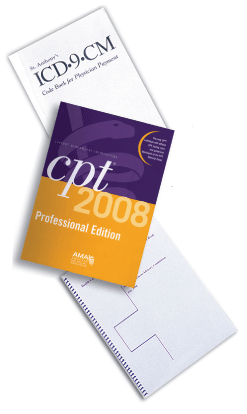 Q: Will any new diagnosis codes take effect before January 1, 2009?
Q: Will any new diagnosis codes take effect before January 1, 2009?
A: Yes. Although not published until the January ICD-9 book, updated diagnosis codes become effective on October 1, 2008. Here is a short list of updated diagnosis codes for ophthalmology:
• 362.20 Retinopathy of prematurity, unspecified;
• 362.22 Retinopathy of prematurity, stage 0;
• 362.23 Retinopathy of prematurity, stage 1;
• 362.24 Retinopathy of prematurity, stage 2;
• 362.25 Retinopathy of prematurity, stage 3;
• 362.26 Retinopathy of prematurity, stage 4;
• 362.27 Retinopathy of prematurity, stage 5;
• 364.82 Plateau iris syndrome; and
• 372.34 Pingueculitis.
There are no ophthalmic ICD-9 codes to be deleted October 1, 2008.
Q: Will any new CPT codes take effect before January 1, 2009?
A: Yes. The American Medical Association (author of CPT) releases new or revised Category III CPT codes at various times during the year. A series of Category III codes released in early 2008 are implemented as of July 1, 2008 (although their publication date is January 2009). However, all Category I CPT codes are effective on a calendar year basis beginning in January. They appear in the annual updated version of CPT and always have a designation indicating "new" in the manual.
Q: What new ophthalmic Category III codes went into effect July 1, 2008?
A: One new code is an add-on code. It cannot be submitted by itself. This specific Category III code is used in conjunction with a pars plana vitrectomy. It is:
• +0190T – Intraocular radiation SRC applicator placement. (List separately in addition to primary procedure; use in conjunction with 67036.)
Two additional Category III codes relate to the surgical management of glaucoma. They are:
• 0191T – Insertion of anterior segment aqueous drainage device, without extraocular reservoir; internal approach; and
• 0192T – external approach.
Q: Do reimbursement rates exist for these new Category III codes?
A: No. Category III codes describe emerging technology and services. The designation of a Category III code does not endorse or approve a procedure. Reimbursement decisions remain at the carrier's discretion.
Q: Did CMS release bonus checks for the 2007 Physician Quality Reporting Initiative?
A: Not yet. The Centers for Medicare & Medicaid Services expects to release bonus checks in August to those who successfully met the reporting criteria in 2007. When released, the check is written to the holder of the tax identification number and not to individual provider numbers. Participation in the program does not guarantee receipt of a bonus payment in August; success depended on meeting specific reporting thresholds. In July, feedback reports available on a secure website revealed a practice's reporting results.
Q: Are there any mid-year revisions to the ASC fee schedule?
A: Yes. Because drug reimbursement updates on a quarterly basis and some drugs are separately reimbursed to the ASC, quarterly updates are made to the ASC fee schedule. For example, HCPCS code J2778 (Lucentis), when utilized in the ASC, reimbursed $406.18 for 0.1 mg from January through March 2008. The ASC update effective April 1, 2008 changed the reimbursement to $405.18 for 0.1 mg. Watch for quarterly updates on the CMS website.
Q: Are there additional deadlines associated with the NPI number implementation?
A: No. The requirement that you use only National Provider Identification numbers on your claims was effective on May 23, 2008. CMS reports a relatively smooth transition, although some carriers did report difficulties. Some physician practices continue to have NPI issues and have been instructed to work directly with the customer service representatives at their local carrier.
Q: Did the NPI deadline affect claims for post-cataract eyeglasses?
A: Yes. On April 1, 2008, CMS published a MedLearn Matters bulletin (MM5771) on the issue of durable medical equipment, prosthetics, orthotics and supplies. With the implementation of NPI billing, it is now necessary to bill covered services on one claim and non-covered services (with modifier EY) on a separate claim.
Modifier EY indicates that an item is non-covered because it was not ordered by a physician. This pertains to those features of eyeglasses that are patient preference, including most tints, scratch coating, anti-reflective coating and polycarbonate lenses for appearance and light weight. These are the upgrades that patients elect to receive that are not medically necessary. This will change the way you submit claims, but should not affect patients since they are already being informed about covered vs. non-covered items.
The original instruction, CMS transmittal (CR5771), issued to the Medicare DME MACs is available at http://www.cms.hhs.gov/Transmittals/downloads/R1368CP.pdf.
Q: What is the likelihood that my local Medicare carrier will change?
A: The likelihood is high. The Medicare Modernization Act of 2003 contained numerous provisions to change the Medicare fee-for-service administrative structure. One of those changes includes integration of the Medicare Parts A and B administrative functions for the fee-for-service program.
Between 2005 and 2009, the creation of new entities called Medicare Administrative Contractors (MACs) provides an integration of claims processing activities. CMS plans to award 19 MAC contracts. Fifteen will be devoted to Part A and Part B services, and four specialty MACs will serve durable medical equipment suppliers.
Q: How does this affect my practice?
A: You may find that your current Medicare carrier is not awarded a contract and/or you may be assigned to a new MAC as part of the redistribution. Watch your carrier website for announcements about upcoming changes.
Q: Have there been any changes to the Medicare enrollment forms?
A: Yes. In February, CMS quietly released new enrollment forms (CMS-855). The changes are minor; however, CMS expects that the new forms be utilized when submitting enrollment information. Carriers accepted the June 2006 version of the 855 until the end of June 2008, after which time the new form(s) had to be utilized. Changes exist on the 855I (enrollment application for individuals), 855B (enrollment application for groups) and 855S (enrollment application for durable medical equipment, prosthetics, orthotics and suppliers). 
Ms. McCune is vice president of Corcoran Consulting Group. Contact her at DMcCune@ corcoran ccg.com.



